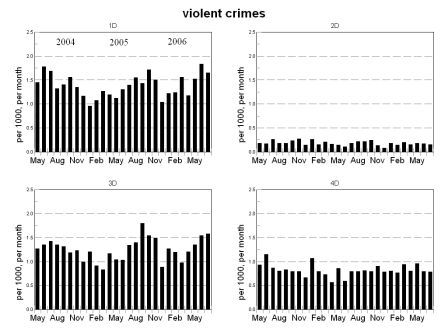A bogus crime emergency |
| On June 11, 2006, Chief Ramsey
declared a "crime emergency" in the District, on the basis of a rash of
homicides, and "double-digit increases in robberies and serious assaults
over the past 30 days". This supposed "spike in crime" led to emergency
legislation by District Council, providing funding for police overtime,
among other things. But is there really a "spike in crime", warranting a "crime emergency"? Commonly the only way to see these things clearly is through a graph. Citing numbers ("double-digit increases") doesn't show enough information. Here I have shown the violent crime data (homicides, assaults, robberies) in the seven MPD districts, and citywide, month by month, since the formation of the current police districts (May 2004). Is there a "spike in crime"? Well, sort of. Every summer, violent crime increases, for reasons which are easily imagined. So one sees an increase in the summer of 2006, much as was evident in the summer of 2005. This is especially evident in District One (downtown), District Three (Columbia Heights, Shaw, Park View), District 5 (Northeast DC), and District 7 (far Southeast). But this year's summertime rise is not significantly different from last year's rise. Why is there a "crime emergency" this year, when there was none last year? What's evident is that there have been a few high-profile crimes (an exceptionally awful robbery-assault-homicide in Georgetown, and several robberies on the National Mall), and this "crime emergency" is in response to public pressure to "do something" about crime, now that crime is occurring where it's unusual. Note the very low violent-crime rates in District 2 (Ward Three, Upper Northwest). Aside from those few events, crime rates in DC are pretty much as usual. If there is a "crime emergency", then it's nothing new, but is merely the daily routine in much of the city. The sad fact is, violent crime in the poverty neighborhoods of DC get little attention, while violent crime in the high-income neighborhoods of the city brings out the politicians anxious to do something -- anything! -- to placate their unhappy, and influential, constituents. After a while, crime will be declared "down" (come cold weather, when violent crime drops), the "emergency" will be declared over, success of the emergency measures will be claimed, and life will go on. But in fact, crime will continue as before, afflicting especially residents of the east side of DC. Nobody is dealing seriously with the fundamental causes of crime: broken families, poverty, alienation, a culture of violence abetted by ready availability of guns, an attitude of "never snitch" about criminal activities among one's peer group, and hopelessness among young men who see no means of getting ahead in life but to rob and steal. |
| Return to home |

